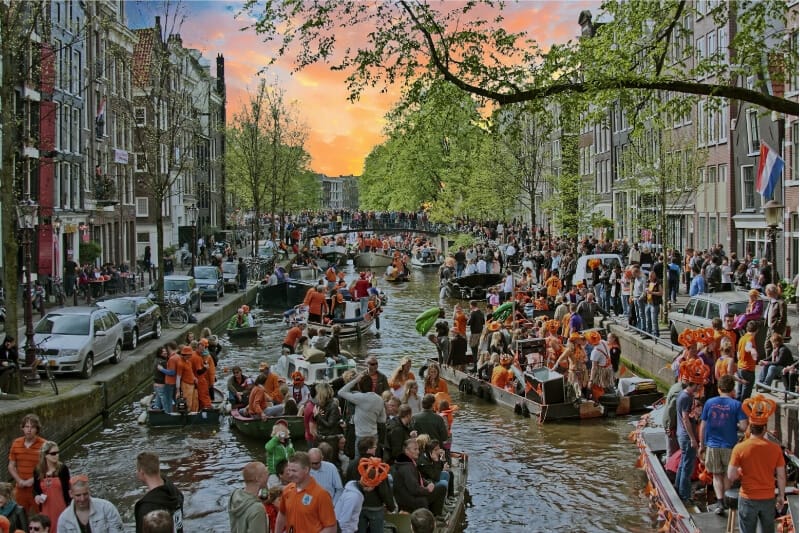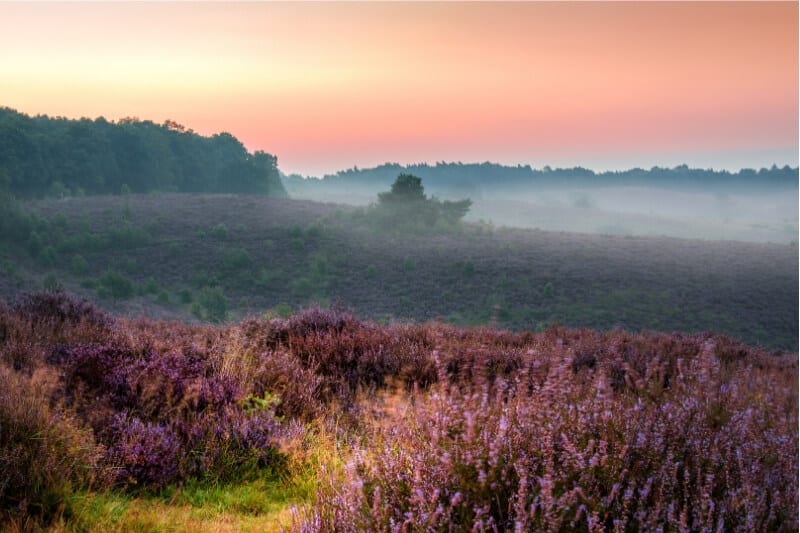Get up close and personal with the culture of the Netherlands with these 7 Dutch traditions – recommended by a local for every traveller to experience.
Mention you’re travelling to the Netherlands and people will usually respond with: ‘Oh, yeah, Amsterdam’. Travellers might also know Kinderdijk, Giethoorn and Zaanse Schans – but that’s about it.
Clogs and cheese: This is how most people experience The Netherlands. But if you ask a local what’s typically Dutch to them, they’ll have a very different answer for you.
Understanding Dutch traditions & culture
First, some background. The Netherlands is a small country with 17 million people in northwestern Europe, neighboured by Germany to the east and Belgium to the south. On its western and northern sides, the country borders the North Sea.
The sea and water in general plays a huge role in the Netherlands’ history and in the lives of its inhabitants. A quarter of the Netherlands is below sea level. Without its dikes and dunes, the country would be a lot smaller. A lot of land has been won and lost on the water, including the famous polders.
Throughout history, the Netherlands’ battle against the water – whether the sea or overflowing rivers – has been a defining factor.
Not unlike Denmark, the Netherlands was and still is a seafaring nation. The Dutch famously traded their way around the whole world, extending their 17th century empire to Asia, Africa and the Americas. The influence of the colonies on shaping Dutch culture can’t be ignored.
People have lived on and off Dutch soil since the early Stone Age. The Netherlands gained independence in 1588 and became a kingdom in 1814. Its current form was achieved in 1830.
7 Dutch traditions for every visitor to the Netherlands
Here are 7 Dutch traditions to show visitors to the Netherlands the best of local culture.
1. Dutch Beer Tasting
The Netherlands is home to several breweries – some of them world-famous, such as Heineken, and some more locally famous, such as Hertog Jan, Texels beer and De Leckere. Many Dutch breweries organise tours and tastings of their beers. You get to see the inside the brewery, learn about the process of making beer, and hear about its history.
Beer has been brewed in the Netherlands since 1 AD. In the Middle Ages, it was usually abbeys that did the brewing until proper breweries became widespread. Today, more people drink beer than wine or any other alcoholic beverage in the Netherlands.
In Dutch culture, beer is very much a social drink. Outside of the country, Heineken is the most prominent Dutch beer, but for locals, it’s considered a special-event beer. Most people prefer other labels.
Participating in Dutch beer culture is easy – join a tasting tour at a local brewery to learn more about the significance of the drink. Or else you can go to a pub or terrace and order a beer on tap, just as the locals do.
2. Dutch Cheese Tasting

The Netherlands is synonymous with cheese, with Gouda, Edammer and Reypenaer among the most recognised varieties. Incredibly, there are around 300 farms in the Netherlands that produce their own dairy products.
Cheese is one of the most cherished Dutch food traditions and has been made in the Netherlands since at least 800 BC. Our love for cheese has earned us Dutch a nickname, kaaskoppen, which literally means ‘cheese heads’.
Cheese is eaten for breakfast or lunch, paired with a slice of bread, or cubed and eaten with mustard as an accompaniment to a drink.
The best way to learn about Dutch cheese culture is through a cheese tasting. Much like a beer tour, a cheese tasting experience involves a walk around the factory and an explanation of the entire process.
Tours in Gouda and Amsterdam are quite touristic, but the tour at Reypenaer is more popular among locals.
3. Celebrate King’s Day

King’s Day, one of the most important Dutch festivals, is celebrated across the country every year on the 27th of April. It marks the birthday of King Willem-Alexander.
As tradition dictates, everyone dresses up in orange and celebrates together on the streets and canals. Jumble sales, musical performances and playing old games from generations past is all part of the tradition. There’s also a lot of drinking at King’s Day parties, especially in Amsterdam.
How to participate in King’s Day as a tourist? First of all, dress up in orange, the colour of the Royal House. If you don’t have an orange shirt, red, white or blue (the colours of the Dutch flag) will do.
Lots of tourists flock to Amsterdam for King’s Day, but in smaller cities and towns, locals have the upper hand. Utrecht, Uden, The Hague and Rotterdam all host wonderful celebrations starting on the night of April 26th, King’s Day Eve.
If you like to party, attend a King’s Day festival and stay up until the next morning. The jumble sale in Utrecht goes on all night, but in many other towns it starts around 7am and finishes in the afternoon.
Just be sure to double check the dates. King’s Day used to fall on April 30th, but now it’s changed to the 27th. If the 27th happens to be a Sunday, King’s Day is held on Saturday the 26th instead.
4. Join The Nijmeegse Four Day Marches
The Nijmeegse Vierdaagse is the largest multiple day marching event in the world and captures an very important part of Dutch culture: love of the outdoors, sport and exercise, and healthy living.
The event is held on the third Tuesday of July every year. Participants walk 30, 40 or 50 kilometres every day for four days, taking in some of the country’s most beautiful landscapes and quaint villages along the way. It’s traditional for participants to stay in locals villages and many families open their homes up to guests. At the end, the Nijmeegse feesten, a huge celebration, is held.
When it was first held in 1909, the march was organised by army soldiers, but this has changed over the years. Nijmeegse has become world-famous, attracting not only Dutch people but participants from all over the world.
Festivities around the march have been organised since 1970, starting the Saturday before and ending on Friday, the final day of the walk. Get involved by either walking the march (or part of it) yourself, or skipping straight to the Nijmeegse festivities. If possible, take the opportunity to stay in a local home – it’s a great way to learn and experience more of Dutch culture.
5. Go Ice Skating
There’s lots of water in the Netherlands – and as soon as it freezes, everyone wants to ice skate. If the cold sustains, tension rise: Will there be an Elftstedentocht?
The Elfstedentocht is an ice skating tour through 11 cities in Friesland province. Known locally as the tocht der tochten (the tour of all tours), it was first held in 1909 and again most recently in 1997.
Even if the Elfstedentocht doesn’t take place, there’s still plenty of opportunities to try ice skating in the Netherlands. There has to be koek en zopie – traditional food and drinks sold on or next to the ice.
In years gone by when winters were colder, people would ice skate in their free time. Koek and zopie stalls have been a Dutch tradition since the 17th century, but their offerings have changed over time. Nowadays koek mostly entails gevulde koeken (butter dough cookies stuffed with almond spice) while zopie, which used to be alcohol, has been replaced with hot coco, glühwein (mulled wine) or even a warm cup of split pea soup.
Donning a pair of skates and heading out on the natural ice (just make sure its thick enough!) or on a rink to skate some rounds is one of the best wintertime activities in the Netherlands. Whichever you choose, make sure you end it with some koek and zopie.
6. Visit The Veluwe

The Veluwe is a vast natural park in the middle-eastern part of the Netherlands, mostly in the province of Gelderland. It’s known for its forests, heather and sand-drifts. A lot of locals say this is the most beautiful part of the country.
It’s a Dutch tradition to escape to Veluwe for a weekend getaway. The area is perfect for hiking and biking.
The Veluwe has its origins in the Ice Age. The lateral moraines (ridges) were formed during the Saale glacial period more than 150,000 years ago. Before that, rivers dumped a thick layer of sand and gravel and thinner layers of clay in the area. In the Saale period, these river sediments where pushed up to form high moraines.
The trees that once thrived were felled in the Middle Ages, allowing the strong winds to get a hold on the sandy soil. This created another natural phenomenon: sand drifts.
Enjoy this national treasure by hiring a bike in Hoge Veluwe National Park and touring around on two wheels. Cycling is quintessentially Dutch, and The Veluwe is the perfect place to try it yourself, away from the chaos of the city traffic.
7. Join The Locals At Scheveningen

The Netherlands isn’t exactly famous for its beaches, but it does have 523 kilometres of shoreline, of which approximately 82% is beach. Visiting the coast may not be on most tourists’ radar, but it’s a very popular activity among locals.
There are a few large beach towns that locals love, including Scheveningen outside of The Hague. Scheveningen was established in the year 1818 as the country’s first official beach resort. At first, it was reserved for wealthy families, but from the 1950s on, it grew in popularity among the country’s working and middle-class.
Whenever there’s a beautiful sunny day in summer or spring, locals hop on the train or in the car and head to Scheveningen. In peak season, you often have a hard time finding a spot to lay down your towel.
Get in on the action by riding the train and tram to Scheveningen. Eat fresh fish and ice cream on the beach, stroll along the pier and boulevard, and enjoy an easy afternoon doing something typically Dutch.
Source: https://wander-lush.org/
